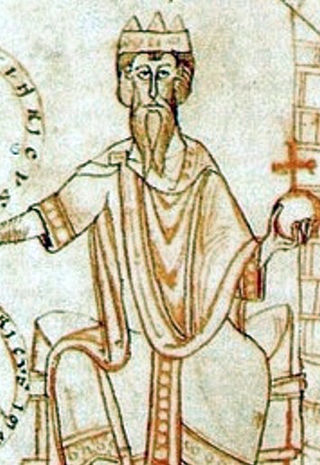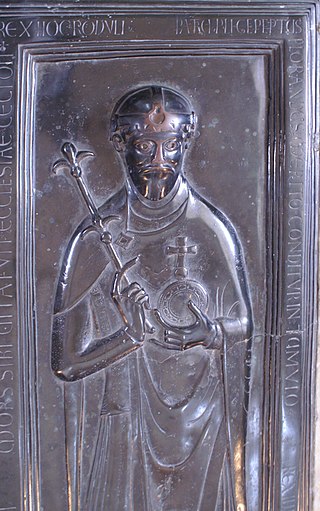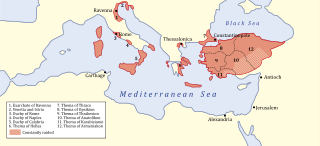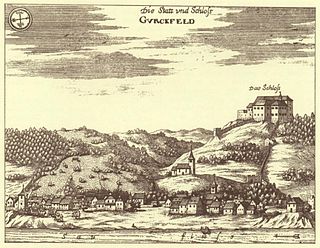
Kravjek Castle (Slovene : Grad Kravjek, German : Schloss Weineck) is a ruined castle northwest of Muljava, in Lower Carniola, Slovenia.

Kravjek Castle (Slovene : Grad Kravjek, German : Schloss Weineck) is a ruined castle northwest of Muljava, in Lower Carniola, Slovenia.
Kravjek was once one of the more important castles of the Duchy of Carinthia. Its first owners were the Dukes of Spanheim, who managed the castle via their ministeriales. This practice resulted in the castle's first indirect mention in a 1243 record of a legal proceeding, in which a "Friderik castellanus de Weinek" [1] was called as a witness. The castle was next indirectly mentioned in written sources in 1254, when its castellan Rajnboto of Jetrbenšek, ministerialis of Duke Ulrik III, donated two farms and two vineyards to Stična Abbey.
The first direct record of the castle dates from 1256, in an agreement signed by the brothers Ulrik and Phillip of Salzburg, dividing their inheritance. Ulrik received Ljubljana Castle and Kostanjevica Castle, and Phillip took possession of the Carinthian castles at Himmelberg and Wernberg, as well as the castles at Sostro and Kravjek. [2]
Phillip sold Kravjek in 1279 to the Patriarchate of Aquileia. [3] It remained a personal fief of the Dukes of Carinthia until 1335, when it passed among the holdings of the duchy itself.

Conrad II, also known as Conrad the Elder and Conrad the Salic, was the emperor of the Holy Roman Empire from 1027 until his death in 1039. The first of a succession of four Salian emperors, who reigned for one century until 1125, Conrad ruled the kingdoms of Germany, Italy and Burgundy.

Carniola is a historical region that comprised parts of present-day Slovenia. Although as a whole it does not exist anymore, Slovenes living within the former borders of the region still tend to identify with its traditional parts Upper Carniola, Lower Carniola, and to a lesser degree with Inner Carniola. In 1991, 47% of the population of Slovenia lived within the borders of the former Duchy of Carniola.

The Duchy of Carinthia was a duchy located in southern Austria and parts of northern Slovenia. It was separated from the Duchy of Bavaria in 976, and was the first newly created Imperial State after the original German stem duchies.

Carantania, also known as Carentania, was a Slavic principality that emerged in the second half of the 7th century, in the territory of present-day southern Austria and north-eastern Slovenia. It was the predecessor of the March of Carinthia, created within the Carolingian Empire in 889.

Rudolf of Rheinfelden was Duke of Swabia from 1057 to 1079. Initially a follower of his brother-in-law, the Salian emperor Henry IV, his election as German anti-king in 1077 marked the outbreak of the Great Saxon Revolt and the first phase of open conflict in the Investiture Controversy between Emperor and Papacy. After a series of armed conflicts, Rudolf succumbed to his injuries after his forces defeated Henry's in the Battle on the Elster.

The Bishop of Gurk is the head of the Roman Catholic Diocese of Gurk, which was established by Archbishop Gebhard of Salzburg, in 1072, as the first suffragan bishop in the Duchy of Carinthia.

The Duchy of Rome was a state within the Byzantine Exarchate of Ravenna. Like other Byzantine states in Italy, it was ruled by an imperial functionary with the title of dux. The duchy often came into conflict with the Papacy over supremacy within Rome. After the founding of the Papal States in 756, the Duchy of Rome ceased to be an administrative unit and 'dukes of Rome', appointed by the popes rather than emperors, are only rarely attested.

Ulrich II, or Ulrich of Celje, was the last Princely Count of Celje. At the time of his death, he was captain general and de facto regent of Hungary, ban (governor) of Slavonia, Croatia and Dalmatia and feudal lord of vast areas in present-day Slovenia, Croatia, Bosnia, Austria, and Slovakia. He was also a claimant to the Bosnian throne. He was killed by agents of the Hunyadi clan under unknown circumstances, which plunged Hungary into civil unrest that was resolved a year later by the sudden death of king Ladislas the Posthumous and the election of Matthias Corvinus, the son of John Hunyadi and Ulrich's son-in-law, as king. Ulrich's possessions in the Holy Roman Empire were inherited by Emperor Frederick III, while his possessions in Hungary were reverted to the crown.

The March of Styria, originally known as Carantanian march, was a southeastern frontier march of the Holy Roman Empire. It was broken off the larger March of Carinthia, itself a march of the Duchy of Bavaria, around 970 as a buffer zone against the Hungarian invasions. Under the overlordship of the Carinthian dukes from 976 onwards, the territory evolved to be called Styria, so named for the town of Steyr, then the residence of the Otakar margraves. It became an Imperial State in its own right, when the Otakars were elevated to Dukes of Styria in 1180.

The Windic March was a medieval frontier march of the Holy Roman Empire, roughly corresponding to the Lower Carniola region in present-day Slovenia. In Slovenian historiography, it is known as the Slovene March.

The Duchy of Styria was a duchy located in modern-day southern Austria and northern Slovenia. It was a part of the Holy Roman Empire until its dissolution in 1806 and a Cisleithanian crown land of Austria-Hungary until its dissolution in 1918.

The Duke's Chair, also known as the Duke's Seat, is a medieval stone seat dating from the ninth century and located at the Zollfeld plain near Maria Saal, north of Klagenfurt in the Austrian state of Carinthia.

The Archdiocese of Salzburg is a Latin Church archdiocese of the Catholic Church in Austria. The archdiocese is one of two Austrian archdioceses, serving alongside the Archdiocese of Vienna.

The Diocese of Gurk-Klagenfurt is a Latin Church diocese of the Catholic Church covering the Austrian state of Carinthia. It is part of the ecclesiastical province of Salzburg. Though named after Gurk Cathedral, the bishop's see since 1787 has been in Klagenfurt.
The Duchy or Ducatus is the denomination for territories occasionally governed separately by members (dukes) of the Árpád dynasty within the Kingdom of Hungary in the 11th-12th centuries. The symbol of the ducal power was a sword, while the royal power was represented by the crown.

Prägrad Castle is a ruined medieval castle in Carinthia, Austria. It is located near Feldkirchen on a hillside above the road to Lake Ossiach.

Krško Castle is a 12th-century castle ruin to the right of the Sava above the old center of the town of Krško, southeastern Slovenia. It stands in the territory of the settlement of Cesta. The castle and town are both named after the nearby Krka River.

Kozjak Castle is a 13th-century castle ruin on a rocky hill above the village of Dolenje Selce near the town of Dobrnič, part of the Municipality of Trebnje in Lower Carniola, Slovenia.
The Liesgau was a shire (Gau) of the Duchy of Saxony in the early medieval period, roughly corresponding to the former Osterode district of Lower Saxony. It was situated on the south-west side of the Harz Mountains in what is now the German state of Lower Saxony. Its southern bound was near the town of Duderstadt and its northern bound near Osterode, and its western bound near the River Leine. Its eastern boundary corresponds to the present-day eastern border of Lower Saxony.

The Battle of Flochberg was a victory for the royal forces of Henry (VI) of Germany over the House of Welf, led by Welf VI and his son, Welf VII. Henry's father, Conrad III, and Welf VI had gone on the Second Crusade together. On his return journey in 1148 Welf had entered into an alliance with Roger II of Sicily, Conrad's enemy. Having agreed to foment discord in Germany, he revived the Welf claim to the Duchy of Bavaria for his nephew, Henry the Lion.